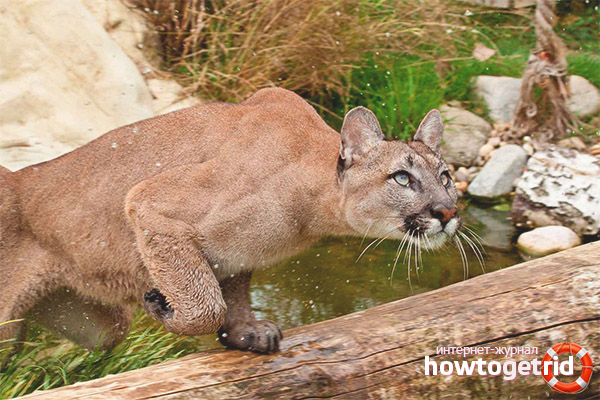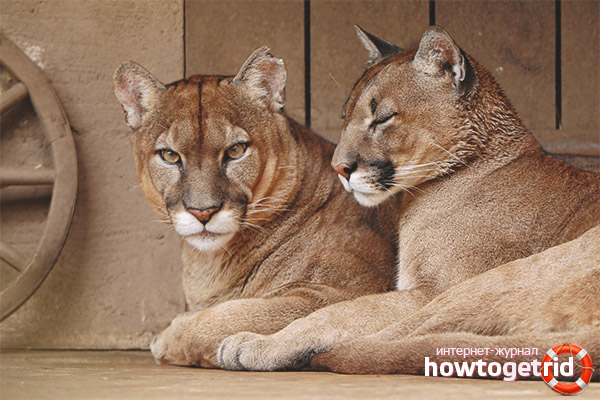The content of the article
Puma refers to a wild cat that lives in the vastness of the United States of America and nearby territories. This animal entered the Guinness Book of Records as a mammal with the largest number of items. It is called a deer tiger, mountain lion, cougar, etc. There are about forty names in English and about the same number in the neighboring languages of various peoples of the world. On the territory of our state, these individuals are familiar to everyone under the name of cougar. They are cunning, unbridled and very dangerous.
Description and habitat
- Representatives of the family are classified as large. They are rivals of the jaguar in their external characteristics. The length of the hull can reach 1.7 m. With a tail, these figures automatically increase to 2.4 m. At the withers, mammals grow up to 70 cm with a body weight of 100 kg. Individuals of male gender are larger than females by 25%.
- The coat in the chest and neck is pigmented red. The head is colored gray, and so-called tassels of tufts of hair are present on the tips of the ears. They are dark, almost black. If you look at the individuals as a whole, then their lower part of the body is highlighted, and the top is dark.
- There are some differences in color, it depends on the area of distribution of animals. For example, the inhabitants of the southern pampas and tropical zones are close to reddish hues. And those that live in the vastness of North America are more silvery. The fur is shortened and dense, not sticking out, lies uniformly, rough in structure.
- These mammals are distinguished by large and strong teeth. According to them, you can determine to which age category the predator is assigned. Fangs of individuals capture game, while incisors serve to tear tissue and crack bones. The tail acts as a balancer, it helps to maintain balance and move quickly.
- The body is muscular, flexible. Despite the large size, animals are mobile and agile. At the same time, they are graceful and measured, causing respect for rivals. The head is small in comparison with the overall features of the case. It has a rounded format. Paws shortened, enormous, with thick bones, muscular. The hind limbs are stronger and more developed, 4 fingers are located on each hand, while the front legs have 5 fingers.
- These animals are common in various landscapes. They are found on flat plains, in tropical thickets, overgrown forest belts, mixed forests, as well as pampas, lowlands and even coniferous areas. The length reaches up to Canada, and originates in the territory of North America. At the beginning of the last century, these animals were almost exterminated in the United States of America, but the population was partially restored.
- To date, cougars are distrustful of outsiders, and therefore excessively dangerous. People try to tame individuals, but they do it badly. The population has partially recovered, its distribution has become similar to lynxes and leopards. Cougars hunt deer, respectively, and they live in areas where there is food.
Status
- Since the early 1970s, these animals have been in official conservation status. These manipulations are designed to preserve the number of livestock with all possible forces. In part, this is being done slowly. It is forbidden to hunt for cougars in America, but poachers have always been and will be. They cause irreparable damage to their craft.
- Shooting is also carried out due to the fact that cougars often destroy livestock. Local farmers have no choice but to grab a gun.However, individuals continue to breed, raise offspring and hide from humans. They adapted to those landscapes on which they had not been before. In the western United States, the numbers of these mammals have resumed. They also became more in the east and south.
Lifestyle
- It must be understood that cougars are classified as wild cats. They are kept separately or together with offspring, partners can be allowed to approach only for the mating season. When couples form, a mating period begins, as evidenced by a loud cat scream throughout the county. These individuals are legible in terms of choosing the locality to live in, they mark the boundaries of territorial ownership using claws or urine.
- It is important that there was food on the territory of residence, and also there was enough shelter. Favorite places are forests and grassy areas planted with vegetation partially or completely. These predators, unlike the self-similar, do not immediately try to occupy a vast territory. If there is enough food, then on a plot of 70 square meters. km will settle about 10 individuals. However, the males choose sites for hunting more, say, 100-300 square meters. km Representatives of female gender are more modest, cost 40-200 square meters. km., taking into account the place for posterity.
- Animals move from one place to another, it all depends on the season of the year. They will not live in the winter and summer at the same site, because it is necessary to obtain food and improve living conditions. In the daytime, cougars bask in the sun or spend most in secluded places. Activity manifests itself at night or at dusk, when the period of hunting begins.
- These mammals move so well through the mountains that they are not confused by even the most complex natural landscapes. They swim, climb tree trunks, overcome stone obstacles in the hope of finding a better place for hunting. Jumps in height are about 2 m., And in length - 6 m. These animals accelerate to 50 km. in hour.
- Due to their strength, cougars can drag prey, which is 6 times more weight than the mammal itself. As for natural enemies, they are practically nonexistent. But flocks of wolves, alligators or jaguars can hunt young or old cougars. Represented individuals try to avoid meeting a person, respectively, so they just do not attack. The exception is cases when people appeared nearby unexpectedly.
Nutrition
- It is noteworthy that predators go hunting mainly with the onset of twilight. Most often, cougars sit in ambush, after which, jumping out, they attack the victim. The cat tries to immediately grab a bite from its prey by jumping onto its back.
- Most often, such animals prey on deer, elk, ungulates, bighorn, and guanaco. It is food of animal origin that forms the basis of the diet of big cats. Often, such individuals attack livestock and even cats and dogs.
- For this reason, American farmers have a strong dislike and anger towards cougars. Individuals often hunt rabbits, coyotes, foxes, gophers, squirrels, mice, fish, birds and even insects. Moreover, cougars always kill more victims than they can eat.
- Cougars by nature are endowed with quick wits, so they often deal even with armadillos, snakes, skunks and porcupines. Big cats try to stay away from water, they do not like to swim. However, if necessary, they can hunt for fish.
- Often, the animals in question hide food leftovers in grass, bushes, and snow. Cats completely cover the meat. Often you can see that the vultures are constantly watching cougars, then to feast on carrion.
- In addition to vultures, coyotes, foxes and other predatory animals also hunt for food debris.Interestingly, in ancient times, the Indians found such hiding places and took meat from wild cats. Thus, people did not have to hunt.
- Separately, it should be mentioned that cougars are endowed with endurance and strength. Such cats can drag prey over long distances. In this case, the mass of the victim can exceed 5 times the weight of the cougar. Often males kill 1 deer per week. As a result, he can hide the carcass and eat it for several days.
- It happens that other animals find the cache, this forces the cougar to hunt again. However, the individuals in question will never themselves eat meat that was obtained by other predators. The cougar will eat only the sacrifice that she killed herself.
Breeding
- As for the mating season, it does not last long. Cougars begin to form pairs for only a couple of weeks. After mating, they disperse. Moreover, only those individuals that have their own plots start reproduction. Males can fertilize several females in the immediate area.
- After mating, the female carries offspring for about 3 months. In one litter there can be from 2 to 6 cubs. They are blind and helpless. After only 10 days, the babies begin to see. Their ears open and their teeth begin to erupt. Cubs are spotted.
- At first, the female protects the offspring and doesn’t even let anyone see him. After 1 month, the mother takes the young for the first walk. The offspring begins to eat solid food from 2 months. Cubs remain with their mother until about 2 years of age. Then they have a full adult life.
Cougars are quite interesting wild cats. Young animals at first try to stay in groups. As soon as they become completely independent, they part. In the wild, cats live up to 18 years. In captivity, this figure is slightly larger.
Video: Puma (Puma concolor)













Submit